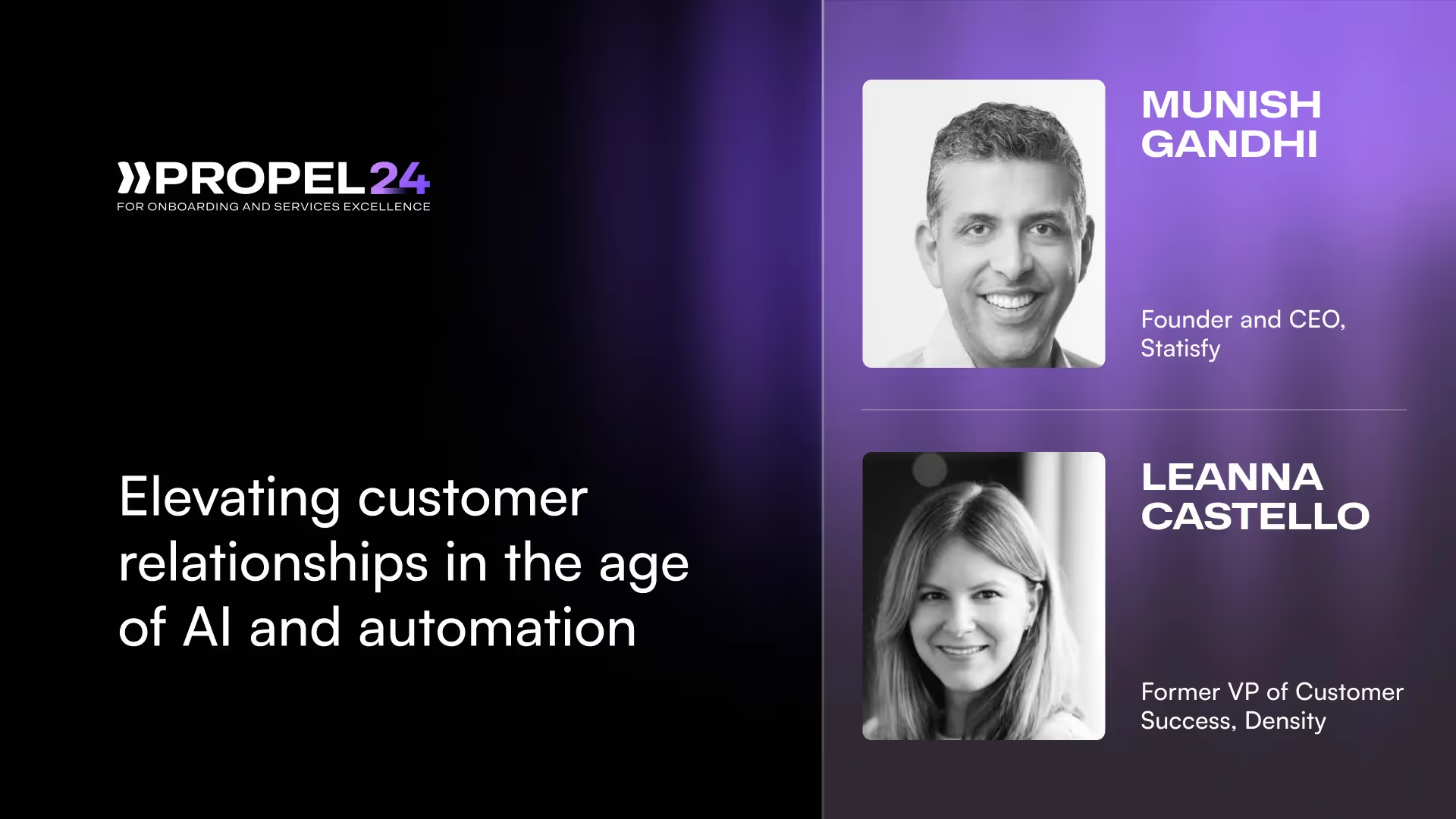AI has the potential to revolutionize various aspects of customer relationships, by providing insights and practical strategies to elevate your customer engagements.
At Propel24, our speakers, Munish Gandhi, and Leanna Castello shared their insights and strategies for leveraging AI to enhance key customer success interactions.
Munish Gandhi, co-founder and CEO of Statisfy, an AI-native customer intelligence platform, shared his expertise on using AI to boost customer engagement. With a rich background and strategic roles at LinkedIn, Bain & Company, HP, and Equinix, Manish is well-versed in driving customer outcomes through innovative technology.
Joining him was Leanna Costello, a seasoned expert in building data-driven, revenue-generating Customer Success organizations. With extensive experience in scaling post-sale teams and a passion for creating exceptional customer experiences, Leanna provided insights into the practical applications of AI in customer success.
At Propel24, they covered:
- The importance of professional relationships
- The customer relationship checklist
- Examples of past learnings
- The engagement model template for consistent customer engagement
Their discussion equipped attendees with a structured approach to harnessing AI for achieving better customer outcomes. Here’s a summarized version of their session.
Why do professional relationships fail?
Research from leading organizations like BCG and Forbes underscores the role relationships play in determining the success of engagements, whether they involve initial implementation or the end-to-end success of a project. Failures in professional relationships can manifest in three specific ways:
1. Lack of executive support: Without a strong relationship with executive leaders, securing the necessary resources and prioritization becomes challenging. This often hinders project success from the outset. Executive support ensures that the project is given the attention and resources it needs to succeed.
2. Poor change management: Effective change management is essential for successful project implementation. When key stakeholders are not engaged and do not understand the reasons for change, projects can stagnate and revert to the status quo. Properly managing change involves clear communication and involvement of all stakeholders to ensure smooth transitions and project acceptance.
3. Misaligned expectations: Successful projects rely on aligned expectations between you, the implementing company, and the client. When there is a disconnect between expectations and capabilities, projects are set up for failure. Ensure both sides have a shared understanding of goals, deliverables, and capacities for achieving desired outcomes.
5 elements of a professional relationship
To increase the probability of success in professional engagements, it is essential to understand what constitutes a good professional relationship. Based on experience and research, Munish and Leanna have identified five key essentials for building strong, enduring professional relationships.
1. Defining mutual benefit
A successful professional relationship begins with a clear understanding of mutual benefits. This involves not only setting initial expectations based on the client's goals and the sales process but also recognizing that these expectations will evolve. As the client becomes more familiar with your solution and as usage expands, their expectations and perceived benefits may change. It is crucial to continuously reassess and align on these mutual benefits to ensure that both parties maintain a consistent and shared understanding of these goals.
2. Building context
A professional relationship is a history of past interactions. Context is about building upon these interactions rather than starting from scratch each time. When there is a history of engagement, conversations progress more naturally and efficiently. This continuity helps in deepening the relationship and making each interaction more meaningful and productive.
3. Maintaining continuity
Continuity involves maintaining a memory of past interactions and applying that context to current and future engagements. This means not only recalling what was previously discussed but also leveraging that knowledge to build trust and strengthen the relationship. Consistent and seamless interactions contribute to a more reliable and trustworthy relationship.
4. Ensuring consistent communication
Consistent communication ensures that neither party is left guessing about the next steps or current status of the project. Clear and regular communication helps in managing expectations and keeps both parties aligned. It eliminates uncertainty and fosters a sense of reliability and predictability in the relationship.
5. Practicing transparency
Transparency is about sharing both the good and the bad. Surprises can undermine trust, so it is better to be upfront about any issues or changes. Transparency also involves ethical behavior and honesty in all interactions. For example, if a team member is leaving or there is an unexpected development, it is important to communicate this openly. This honesty helps in building and maintaining trust over time.
Focusing on these five elements—mutual benefit, context, continuity, consistent communication, and transparency— allows businesses to assess and improve client relationships, ensuring that they are robust and capable of withstanding challenges in the age of AI.
The customer relationship checklist
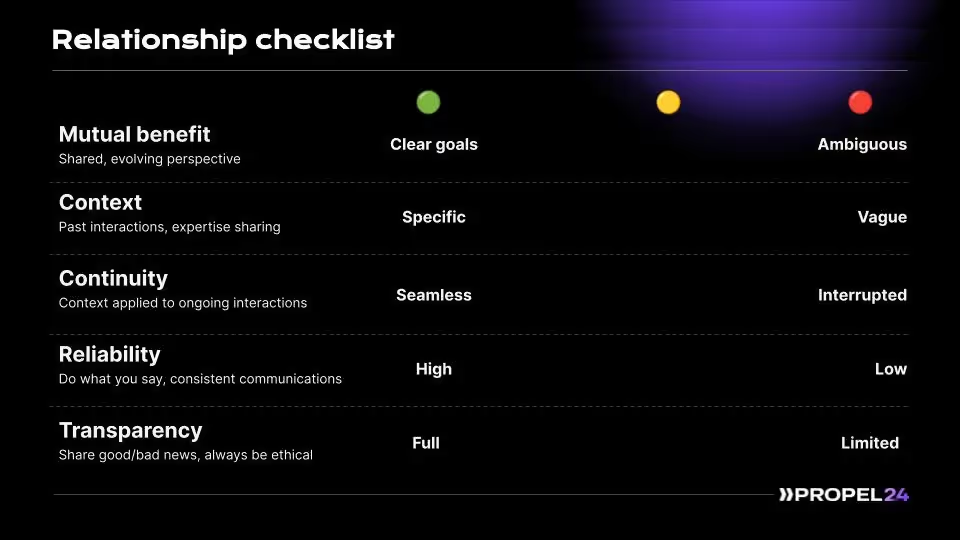
Strategic account management is a complex and time-consuming endeavor. It requires executive-level communication, a deep understanding of each client's business, and the ability to build individualized relationships with numerous stakeholders. This section explores specific examples of customer interactions and demonstrates how today's AI technology can empower your team to streamline administrative tasks, be more strategic, and proactively manage customer relationships.
Example 1: Setting the right context
In one instance, Munish and Leanne’s team worked with a Fortune 100 telecommunications company, on a solution that was to be deeply integrated into their business processes. Their client’s technology played a crucial role whenever they opened or closed offices, involving significant implementation work and constant collaboration. Despite the clear benefits to the customer, the relationship was somewhat one-sided. The executive saw them as a vendor, not a partner, and program ownership was fragmented with limited accountability, complicating timely information retrieval. The situation became even more challenging when the executive left mid-negotiation of a Master Services Agreement (MSA), and a new team took over.
This transition, though daunting, presented an opportunity for Munish and Lenna’s team to strengthen their relationship. They entered the research and resell mode, compiling proof points and leveraging the history of their interactions to demonstrate value to the new executive.
They quickly secured a meeting with the executiveand presented a clear ROI, highlighted the mutual benefits, and showed how they could facilitate a smoother transition for the new executive. This transparency and proactive approach led to successful MSA negotiations, correct staffing on the customer's side, and ultimately, a shorter time-to-value for their implementations.

How AI can help set the right context for professional relationships
AI, particularly customer sentiment analysis modules, can significantly enhance the management of professional relationships. These tools can track customer interactions across various platforms such as Zoom, email, and messaging apps, providing insights into customer sentiment. You can use AI to alert you about changes in customer sentiment (e.g., through a red, yellow, and green status system), so you can understand the reasons behind these changes. This allows you to take actions to address concerns proactively and maintain a positive relationship.
Many administrative tasks can be automated with AI, freeing up time for teams to focus on strategic activities. This includes scheduling follow-ups, generating reports, and managing routine communications, all of which contribute to smoother and more efficient interactions with customers.

Example 2: Acting on customer sentiment
Not every customer scenario has a happy ending. This example underscores the importance of vigilance and early intervention when things aren't going well.
Once, Munish and Leanna’s team had a company with which they had conducted small pilots, and now had the opportunity for a significant expansion. However, the customer requested a highly customized product feature that was unique to their needs. After agreeing to commercial terms that made sense for their business, they entered into a contract and embarked on this project, anticipating substantial benefits despite the trade-offs to the broader roadmap.
Midway through the engagement, the executive overseeing the project left, and the new executive who inherited the program was not particularly engaged. The team mistakenly interpreted the status quo as a positive sign and assumed everything was moving as expected. However, as the project progressed, their day-to-day contacts became less reliable and transparent, signaling underlying issues. The wake-up call came when the client failed to even process their first invoice.
After considerable effort to engage with the stakeholders, came the discovery thatthe new executive did not buy into the mutual benefits of their program. They had changed the requirements and were unwilling to allocate the necessary IT resources to make the project successful.
Ultimately, the team had to part ways with this customer. While they recouped some funds, they lost a key client and incurred significant opportunity costs by diverting resources from other customers.
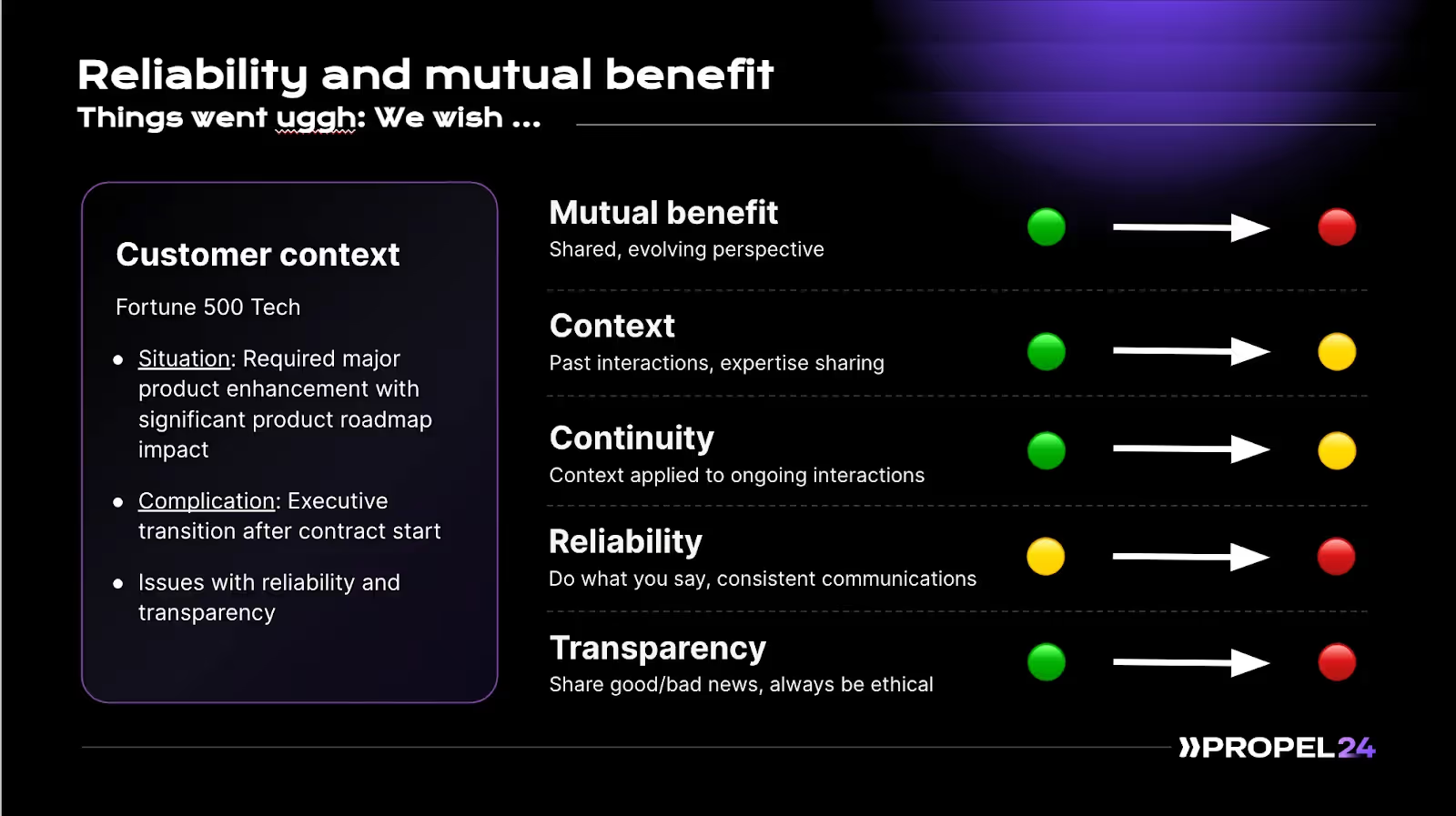
How AI can help you act on customer sentiment
AI can play a crucial role in monitoring all interactions and helping you understand evolving customer goals. During transitions, such as executive changes, AI can track shifts in customer requirements and expectations, providing early warnings of potential issues. For example, if stakeholders are not engaging or responding to emails for extended periods, AI can infer negative sentiment and prompt leadership to take proactive measures.
AI systems can systematically track customer goals, ensuring that evolving expectations are met and that any disconnects are addressed promptly. By providing real-time insights into customer sentiment and engagement levels, AI enables teams to identify and act on potential problems before they escalate, fostering stronger relationships.
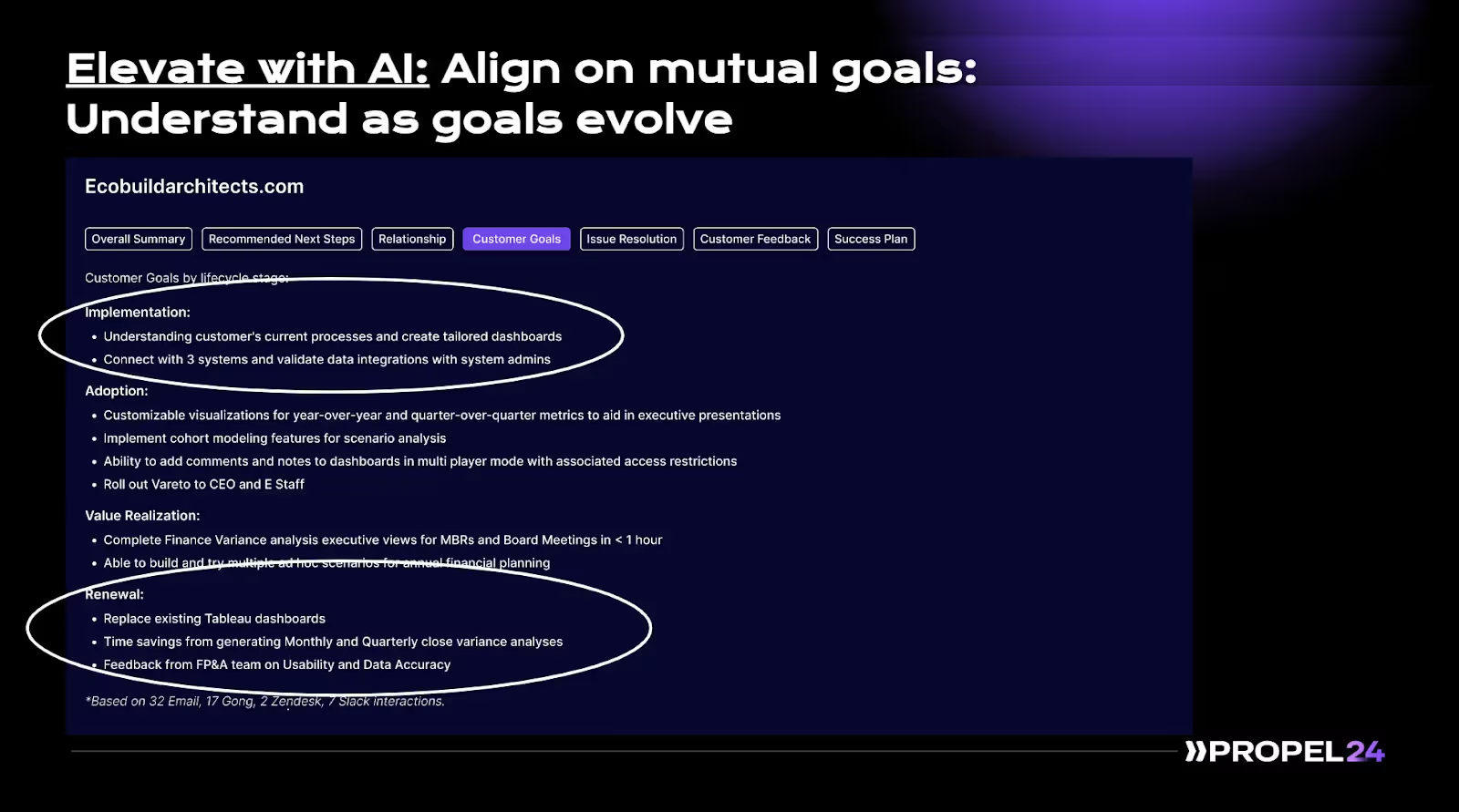
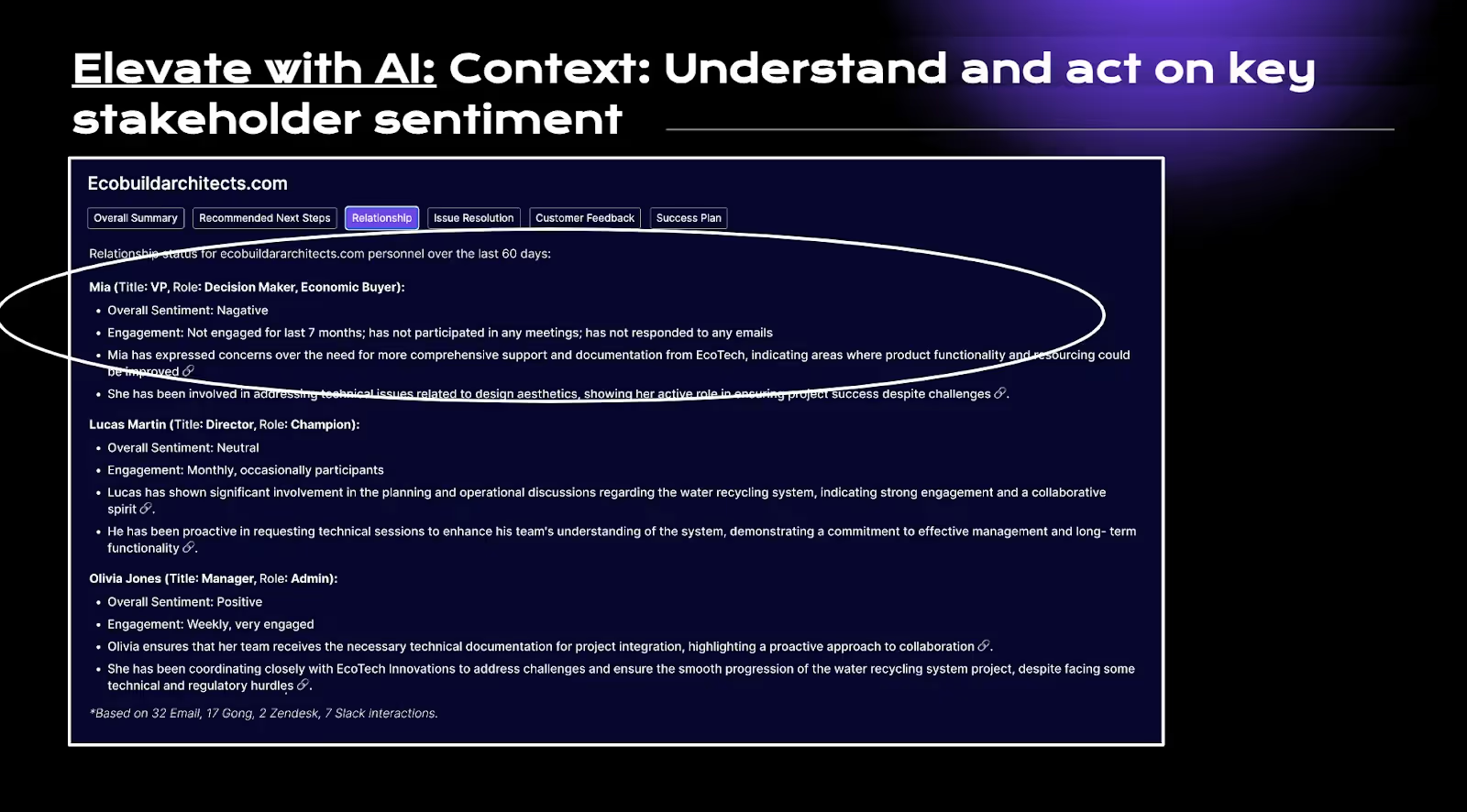
Example 3: Building trust
Rebuilding trust is a challenging process that requires time and consistency. In this instance, Munish and Leanna’s team had a successful pilot with a strategic account that led to a decision to deploy their solution across all North American locations. However, the complexity of this broader deployment far exceeded what the initial pilot suggested, leading to significant implementation difficulties.
As the program began to be used, the customer identified issues with the data in the system—issues they noticed before the implementation team did. This miss led to increasing customer frustration. In addition, the time it took to resolve the issues compounded the customer's dissatisfaction and started eroding their trust in the product and team.
Recognizing the critical situation, Munish and Leanna’s team quickly initiated a complete reset. They adopted a hyper-transparent approach, allocating resources for a comprehensive audit of the customer's implementation and data. They developed a detailed project plan, which was shared with the executive team to demonstrate their commitment to resolving the issues. A regular cadence of status check-ins was established and a transparent, systematic process was maintained for addressing and resolving all issues.
This rigorous and transparent effort took months to rebuild the relationship, proving that reliability and transparency are essential from the start. However, the team was able to regain the customer's trust and rebuild their champions within the account by consistently demonstrating commitment and improving their product's performance.
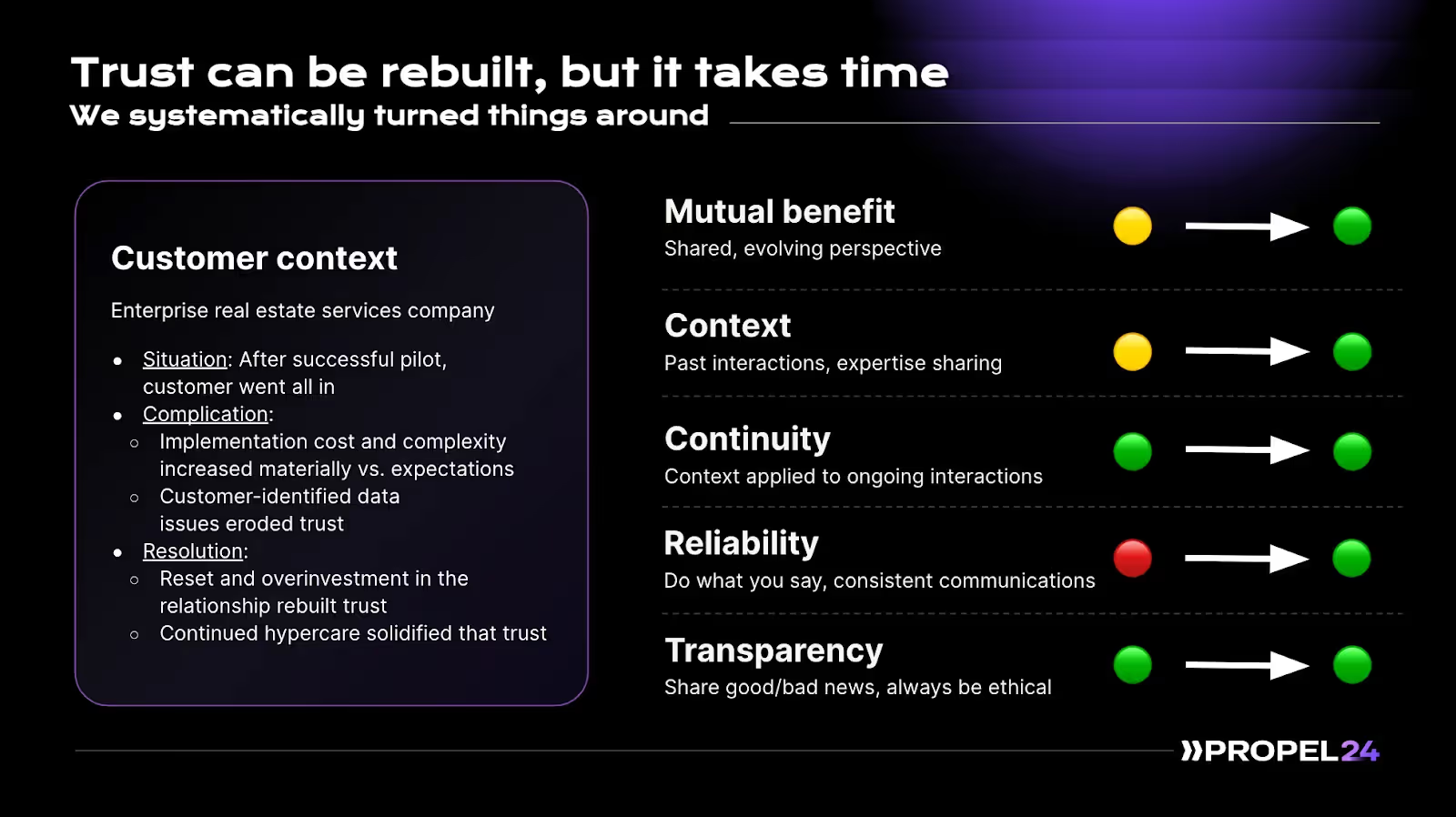
How AI can help with transparency
AI can significantly enhance transparency by systematically tracking and following up on action items. After capturing the essence of discussions and action items from meetings, AI can automate the follow-up process, ensuring that all tasks are tracked and completed in a timely manner. This systematic tracking helps in maintaining a clear and transparent workflow, providing customers with real-time updates and assurances that their concerns are being addressed proactively. Businesses can foster greater trust and transparency with their customers by using AI to ensure consistent follow-through.
AI tools can also help businesses with actionable follow-throughs on every customer interaction by systematically tracking action items, deadlines, and task completions, ensuring that nothing falls through the cracks. This leads to more reliable and efficient project management.
How AI helps streamline customer engagement
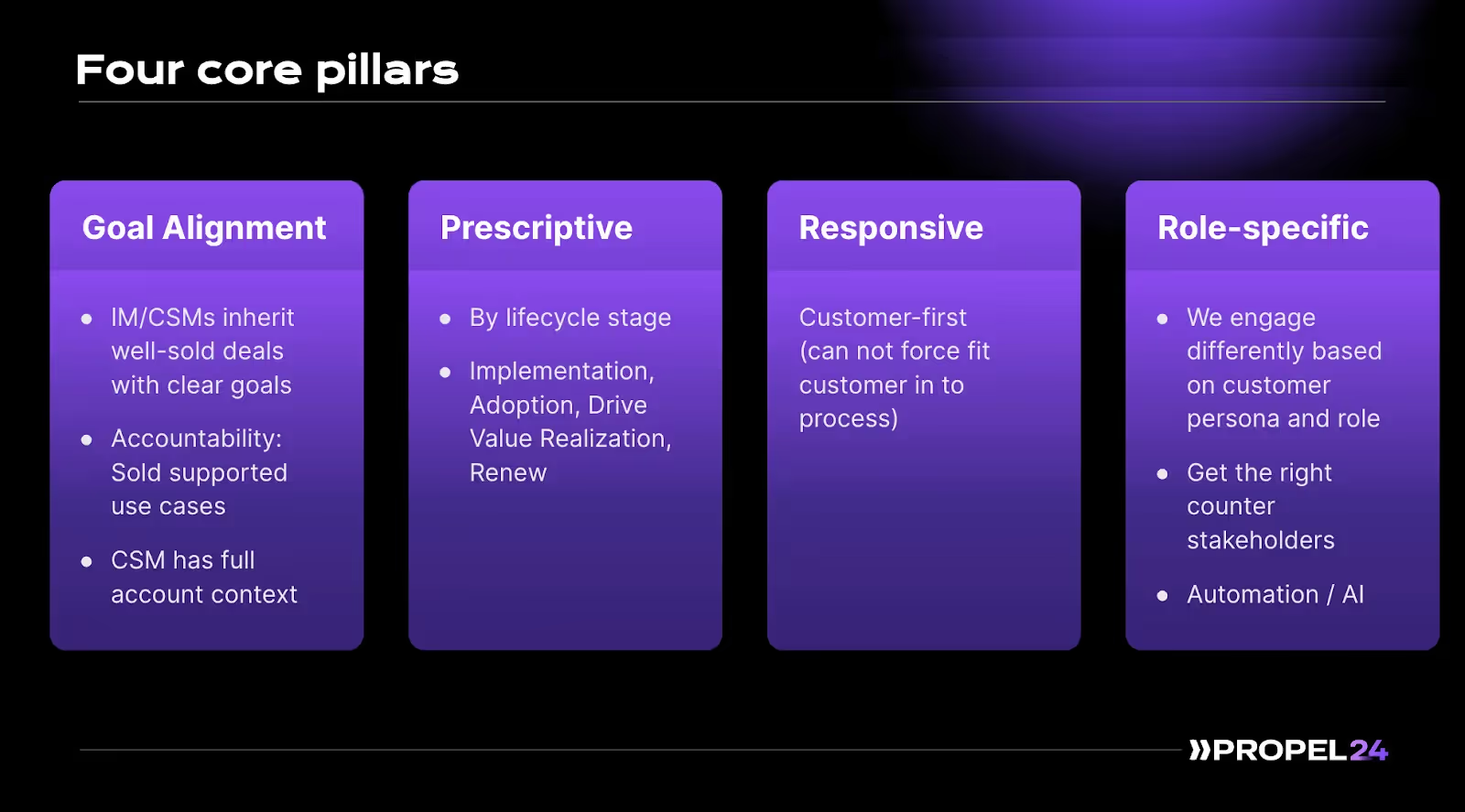
Four core pillars stand out as universally crucial for enabling customer engagement, regardless of your business size. These include:
1. Goal alignment
Understanding and aligning with your customer's goals is the foundation of any successful engagement. This means knowing what the customer aims to achieve and ensuring that your company's offerings support these objectives. Customer Success Managers (CSMs) need to have a thorough account context, including knowledge of why the customer made the purchase and who the key stakeholders are.
2. Prescriptive action
A proactive approach is essential. Instead of teams having to figure out each step of the customer's lifecycle, there should be a clear, documented process or technology-driven system guiding them. This ensures that the team knows the next best action to take at any given point, enhancing efficiency and effectiveness.
3. Responsiveness
Timely and relevant follow-ups are critical. Engaging with the customer at the right moment, in the right manner, and with the right people ensures that interactions are meaningful and productive. This just-in-time approach helps maintain momentum and keeps the engagement on track. AI can automate these routine follow-ups and structure communication to be timely and relevant. This improves the responsiveness of teams, ensuring that customers receive prompt and appropriate interactions.
4. Customized communications
Effective communication is tailored to the individual roles within the customer’s organization. Especially in strategic accounts, it's important not to send generic messages to everyone. Communication should be personalized to fit the specific needs and expectations of different personas within the customer’s team, ensuring that each interaction adds value. AI can analyze customer sentiment at a granular level, helping teams understand and address concerns specific to different stakeholders. This leads to more personalized and effective engagement strategies.
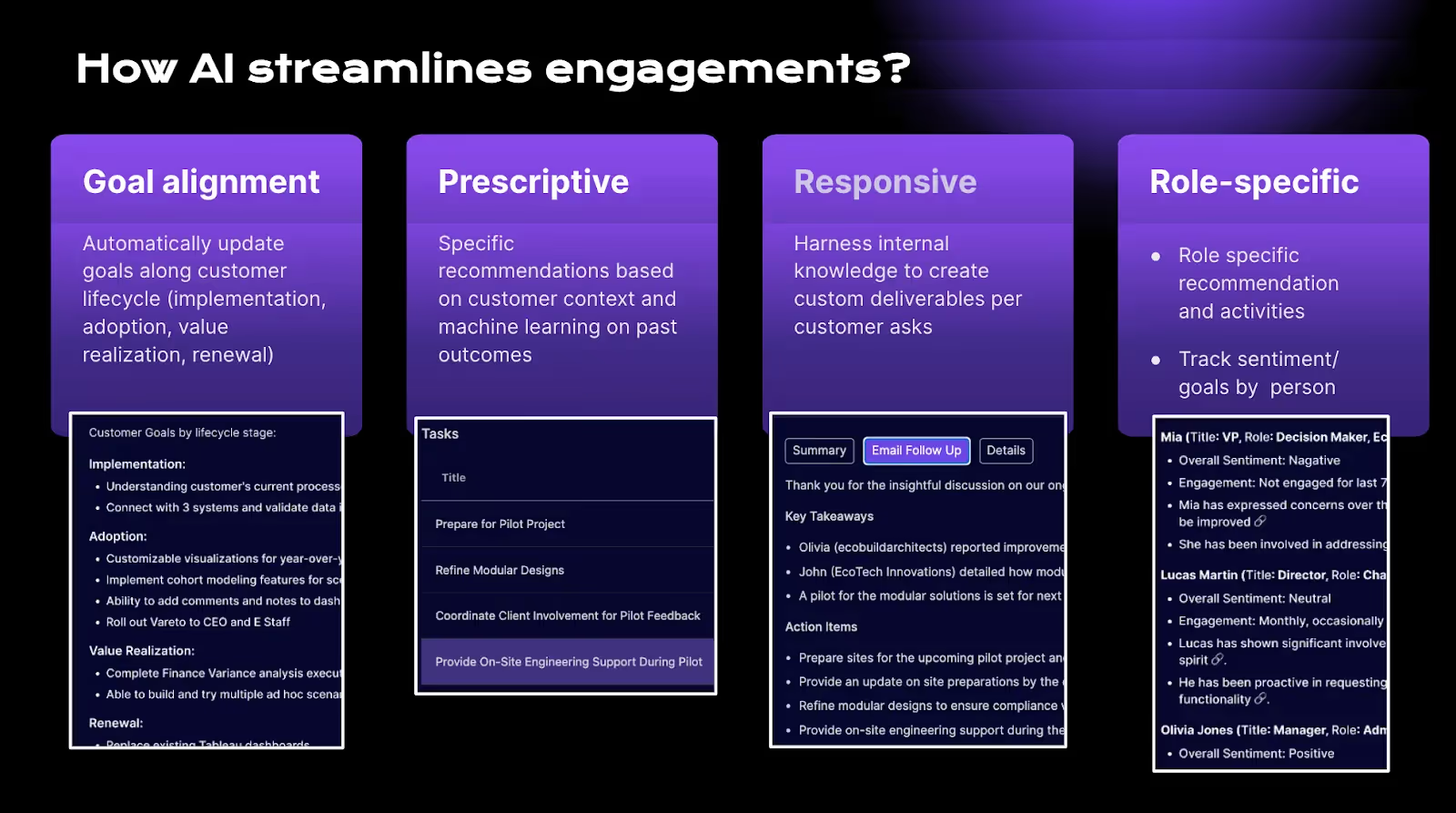
Building and maintaining strong customer relationships involves three key aspects:
- Assessing relationship strength with a relationship checklist
- Consistently engaging with customers through a structured engagement model, and
- Leveraging AI to enhance and elevate these relationships.
Q&A with Munish Gandhi and Leanna Castello
Question: What future AI developments do you foresee having the most significant impact on the professional services industry?
Answer: The potential for AI in professional services is vast. One of the most exciting developments is the ability of AI to surface critical information to teams just in time, rather than requiring them to dig for insights. For instance, AI can alert CSMs to changes in customer behavior, such as a shift in user activity or the addition or removal of users from an account. This reduces noise and highlights significant signals, allowing CSMs to act swiftly and effectively.
AI offers a framework for evaluating customer relationships across various dimensions, helping us proactively address situations and leverage intelligence in our daily workflows. Embracing AI can greatly enhance our ability to manage and improve customer relationships.


